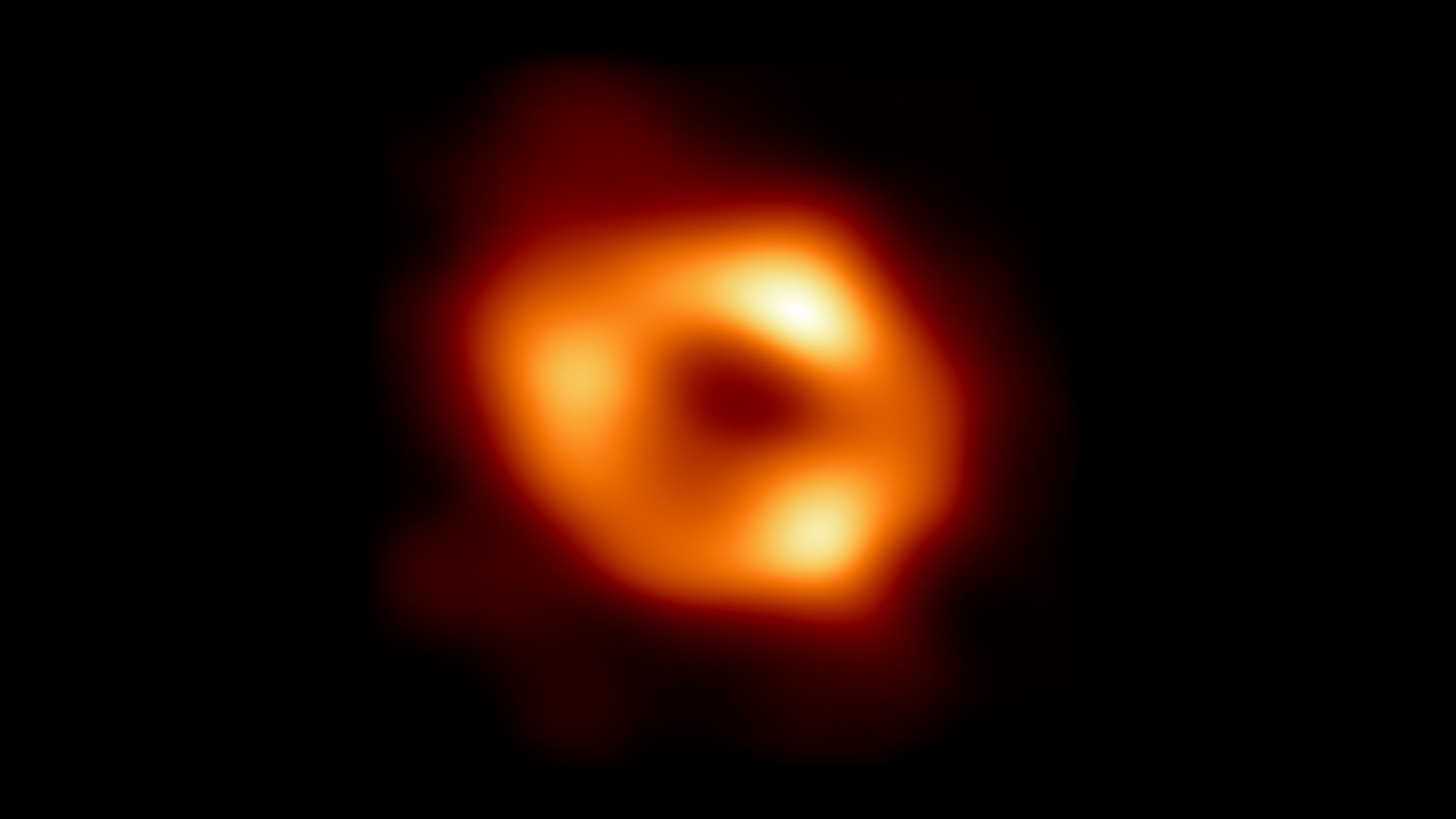
You’d think it would be hard to overlook an object with a mass four million times greater than the sun. But when that object is a supermassive black hole like Sagittarius A*, the giant object astronomers have long believed sits at the center of our galaxy, it is, by definition, impossible to see. Black holes, after all, are collapsed objects with a gravitational pull so great that not even light can escape.
All the same, this morning, at a National Press Club even in Washington, D.C., representatives of a team of 300 astronomers from 80 institutes around the world, released the first ever image of Sagittarius A*—or, more specifically, of the super-heated matter swirling around it and destined to be swallowed by it.
The image, which somewhat resembles a fuzzy orange doughnut, was captured by the Event Horizon Telescope (EHT), a necklace of 11 radio telescopes arrayed around the world operating together as one massive observatory. The black hole captured by the EHT, said University of Arizona astronomer Feryal Ozel during the unveiling, is “the gentle giant in the center of our galaxy.”
That “gentle” descriptor is true only to a point. Black holes are violent objects, shredding and swallowing stars and other matter whole. Indeed, the EHT gets its name from the so-called event horizon surrounding a black hole—or, the point at which the gravity of the object grows so great that anything near it falls inside, never to be seen again. Black holes can be so small and the objects they swallow so large that, as Sheperd Doeleman, the director of the EHT put it to the Washington Post in an interview before the image was released: “Imagine sucking an elephant through a straw.”
Astronomers believe supermassive black holes like Sagittarius A* sit at the center of nearly all galaxies, providing a sort of gravitational and structural pivot point around which the galaxy slowly rotates. It is currently unclear whether supermassive black holes form first and galaxies then take shape around them, or the galaxies form first and the supermassive black hole coalesces at their center. Either way, what keeps us safe from Sagittarius A*’s ravenous gravitational appetite is simple distance: the supermassive object sits a comfortable 27,000 light years from Earth.
Sagittarius A* gets its name from the spot in the constellation Sagittarius from which, in 1933, engineer Karl Jansky first detected a powerful radio signal streaming toward Earth. As the science of black holes matured over the decades that followed, astronomers began to suspect that just such a body could be the source of the energy Jansky spotted.
Supermassive black holes are, as their name suggests, vastly larger than ordinary black holes, which are the remains of smaller collapsed stars—those with a mass about 20 times that of our sun. Our galaxy is thought to be dotted with up to 100 million of these stellar-mass black holes. The supermassive variety is a far less common species.
Sagittarius A* is only the second supermassive black hole ever to be imaged. The first, Messier 87, was captured by the EHT in 2019 and it is an absolute beast. Located 53 million light years from Earth, it is estimated to be about 1,500 larger than Sagittarius A*.
That size differential is important to scientists since it’s long been assumed that supermassive black holes exist in a whole range of different masses. This belief then raised the question about whether the physics of the objects would be the same regardless of their size. Now we have a chance to match them up against each other.
“Despite being 1,500 times smaller than M87*, the new images of Sagittarius A* look remarkably similar to those of M87*,” Avery Broderick, a professor at the University of Waterloo, who is a part of the EHT team, said in a statement. “Nobody knew for sure if enormous black holes and relatively smaller ones would share much in common, but now we have two unique black holes to compare, so we can better understand how black holes of different sizes eat, how they grow, and how they shape the galaxy around them.”
The more the EHT scans the sky, the more supermassive black holes it is likely to discover, and the deeper our understanding of these mysterious objects is likely to become. It was for Albert Einstein in the early part of the 20th century to first posit the theories of gravity that gave rise to the idea of black holes. It is for his scientific heirs in the 21st century to take the objects’ pictures—and unravel their secrets.
More Must-Reads from TIME
- Donald Trump Is TIME's 2024 Person of the Year
- Why We Chose Trump as Person of the Year
- Is Intermittent Fasting Good or Bad for You?
- The 100 Must-Read Books of 2024
- The 20 Best Christmas TV Episodes
- Column: If Optimism Feels Ridiculous Now, Try Hope
- The Future of Climate Action Is Trade Policy
- Merle Bombardieri Is Helping People Make the Baby Decision
Write to Jeffrey Kluger at jeffrey.kluger@time.com